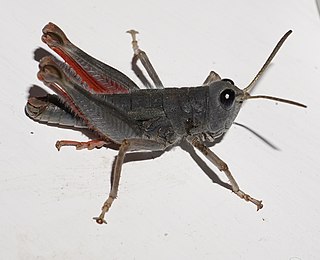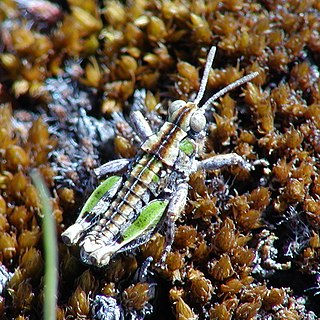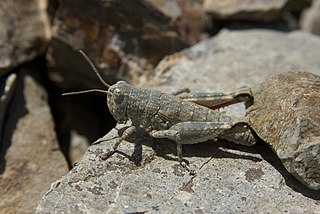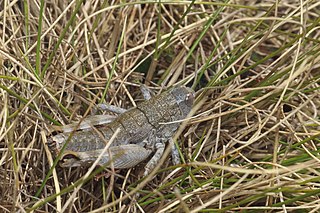
Porters, is a commercial ski resort just over an hour's drive (98km) west from Christchurch, in the South Island of New Zealand. Originally functioning as a club skifield, it has one beginner magic carpet, one platter tow, one chairlift and three t-bars. The difficulty of the slopes is distributed as 15% beginner, 35% intermediate and 50% advanced. Modern grooming equipment is used, and snowmaking facilities operate along the main pistes along the chairlift.

Isoplectron is a genus of cave wētā in the family Rhaphidophoridae with three species currently recognized. The genus is endemic to New Zealand and distributed throughout the country.

The African rice grasshopper, Hieroglyphus daganensis is a medium-sized grasshopper species found in the Sahel region. Although not called a locust in English, this species shows gregarious behaviour and some morphological change on crowding and may become a moderately important pest species for small-holder farmers in the region.
The Sinbad skink is a rare species of medium-sized skink endemic to New Zealand where it lives in an alpine habitat in Sinbad Gully, in Fiordland National Park.

Sigaus childi is an endangered protected species of grasshopper known only from the Alexandra district of the South Island of New Zealand. It is one of just two species of grasshopper listed for protection under the New Zealand Wildlife Act 1953. It is currently classified as "At Risk, Naturally Uncommon" by the Department of Conservation. The genus Sigaus is endemic to New Zealand.

Brachaspis robustus is a nationally endangered species of grasshopper endemic to the Mackenzie Basin of the South Island of New Zealand. The genus Brachaspis is endemic to the South Island of New Zealand. Although a grasshopper, it is a poor jumper, relying on camouflage to hide from predators. It is threatened by introduced mammals such as stoats, hedgehogs, and rats.

Sigaus villosus is New Zealand's largest grasshopper. It is only found in the central mountains of the South Island. The genus Sigaus is endemic to the New Zealand. Like all of New Zealand sub-alpine and alpine grasshoppers S. villosus has a 2 or 3 years life cycle. The eggs must ‘overwinter’ before they will hatch. Hoppers are found throughout the year and adult grasshoppers can be found throughout the New Zealand summer between December and April. Adult S. villosus do not overwinter.

Alpinacris tumidicauda is a species of grasshopper only known from Otago and Southland, New Zealand. The genus Alpinacris is endemic to the South Island of New Zealand. A. tumidicauda was described in 1967 by Robert Sidney Bigelow, with a type locality of Obelisk in the Old Man Range (45°19′22″S169°12′27″E). A male holotype and paratype are deposited in the Canterbury Museum, Christchurch. Like all of New Zealand sub-alpine and alpine grasshoppers, A. tumidicauda has a 2- or 3-year life cycle. The eggs must "overwinter" before they will hatch. Hoppers are found throughout the year, and adult grasshoppers can be found throughout the New Zealand summer between December and April. The adult A. tumidicauda do not overwinter.

Sigaus of grasshoppers in the tribe Catantopini that isendemic to New Zealand, and all but one species is endemic to the South Island: Sigaus piliferus is the only North Island representative and is the type species. There are eight species in the genus; all are flightless, and many are coloured for camouflage against rocky ground. Sigaus minutus and S. childi are threatened with extinction.

Sigaus australis is the most common alpine grasshopper found in New Zealand. It can be found in the southern half of the South Island above the tree line. Sigaus australis was described in 1897 by Frederick Hutton. Like all of New Zealand sub-alpine and alpine grasshoppers S. australis has a 2 or 3 years life cycle. Individuals can survive the cold by freezing solid at any life stage, at any time of the year. Sigaus australis adults are relatively large grasshoppers. The genus Sigaus is endemic to New Zealand.

Arcyptera fusca, the large banded grasshopper, is a species of 'short-horned grasshoppers' belonging to the family Acrididae subfamily Gomphocerinae.

Calliptamus italicus, the Italian locust, is a species of 'short-horned grasshopper' belonging to the family Acrididae, subfamily Calliptaminae.

Calliptamus siciliae, commonly known as the pygmy pincer grasshopper, is a species of short-horned grasshoppers belonging to the family Acrididae subfamily Calliptaminae.

Alpinacris crassicauda is a species of grasshopper only known from West Coast Region and Tasman Region, New Zealand. The genus Alpinacris is endemic to the South Island of New Zealand. A. crassicauda was described in 1967 by Robert Sidney Bigelow, with a type locality of Lead Hills, Boulder Lake. A male holotype and paratype are deposited in the Canterbury Museum, Christchurch. Like all of New Zealand sub-alpine and alpine grasshoppers A. crassicauda has a 2 or 3 years life cycle. The eggs must ‘overwinter’ before they will hatch. Hoppers are found throughout the year and adult grasshoppers can be found throughout the New Zealand summer between December and April. The adult A. crassicauda do not overwinter.

Phaulacridium marginale is a small species of short-horned grasshopper in the family Acrididae. It is endemic to New Zealand where it is found in low elevation open habitat throughout North Island, South Island, Stewart Island and on many smaller islands.

Stenobothrus rubicundulus, common name Wing-buzzing Grasshopper, is a species of short-horned grasshoppers in the family Acrididae.

Phaulacridium otagoense is an endemic New Zealand grasshopper found at low elevation throughout the central South Island.

Sigaus minutus is a species of short-horned grasshopper in the family Acrididae. It is one of the smallest and rarest species of grasshopper in New Zealand, found only in the Mackenzie district of South Island. There are nine species within the genus Sigaus described by Bigelow (1967), all endemic to New Zealand. The population status of Sigaus minutus is declining according to threat assessments made by orthopteran experts in 2010.

Brachaspis nivalis, is an alpine short-horned grasshopper, endemic to the South Island of New Zealand. Brachaspis nivalis is brachypterous and flightless, therefore they travel by hopping. They bask during the day so need open habitat.

The Green Rock-hopper grasshopper, Brachaspis collinus is an alpine species of short-horned grasshopper in the family Acrididae. It is found in New Zealand in the mountains of northern South Island, above the tree line and as high as 2000 m asl. In New Zealand alpine grasshoppers can freeze solid at any time of the year and are alive when they thaw out when temperatures rise.
























